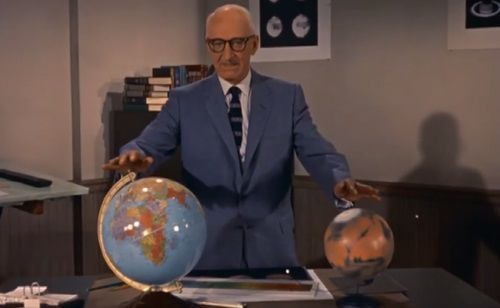VIEW FROM MARS HILL
View from Mars Hill: Lowell astronomer had star turn on 1956 Disney TV show

The late Lowell astronomer Earl Slipher, as shown in a still from the 1956 "Man and Mars" episode of the TV program, "Disneyland."
Courtesy
On October 27, 1954, the television show “Disneyland” premiered on ABC. Designed partly to advertise the Disneyland resort park, which opened on July 17, 1955, this was an important event in the history of entertainment because it was the first television show produced by a major movie studio. At the time, movie studios were skeptical of television, thinking that this expanding media would ruin the motion picture industry. With this new show, however, Walt Disney and his studio proved otherwise. The show also was effective in helping build support for the U.S. space program. Through the years, the show featured various animated and real-life programming and boasted a guest list that included a longtime Flagstaff resident.
Each “Disneyland” episode had its own theme, which often paralleled one of the theme park’s attractions. For instance, one focused on Frontier Land and featured Davy Crockett. In 1956, the Disney studio was planning a Tomorrow Land show called “Man and Mars.” It would introduce the universe and then narrow the discussion to Mars, highlighting the historical understanding of the planet, speculation on life, and the possibilities of traveling there.
To discuss the segment about travel to Mars, the studio contracted the services of rocket scientists Werner von Braun and Ernst Stuhlinger. For the general discussion about Mars, the studio contacted an institution long known for its research about Mars – Lowell Observatory. In a letter to Observatory director Albert Wilson dated March 13, 1956 (coincidentally, this would have been Observatory founder and Mars specialist Percival Lowell’s 101st birthday), producer and director Ward Kimball and assistant director William Bosche requested the Observatory’s assistance in creating the show. They wanted to come to Flagstaff and gather live footage of the facilities and staff. They also wanted one of the Lowell astronomers to travel to the Disney studio to narrate part of the show.
On March 15, Wilson responded favorably, suggesting astronomer E.C. Slipher would serve as the narrator. Slipher was widely recognized as one of the world’s leading experts on Mars. Within two weeks, Kimball sent Wilson a script and storyboard for the show, pointing out that the text was kept simple “so that the average viewer won’t switch stations to ‘Liberace’ and his piano.”
Filming for the Mars program was done at Lowell in April, for which the studio paid $1,350 in rental fees and costs to cover Observatory staff salaries. In May, Slipher flew out to the Disney studio for filming of his narration piece. In writing about Slipher, Kimball noted, “Dr. Slipher did very well before the cameras. We put horn-rimmed glasses on him and everybody who has seen the footage comments that he looks like a typical astronomer.” Slipher was paid a $500 honorarium for his part.
The program, eventually called “Mars and Beyond,” was released as a theatrical featurette on December 4, 1957. In the approximately eight-minute segment featuring Lowell Observatory and Slipher, colleagues V.M. Slipher (E.C.’s brother) and Henry Giclas also made short appearances. The show aired on “Disneyland” on December 1957, and today is considered by many a classic Disney production.
Kevin Schindler is the Lowell Observatory historian.
No comments:
Post a Comment